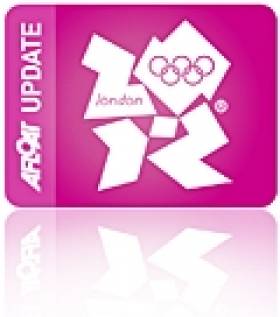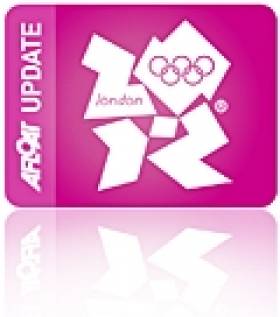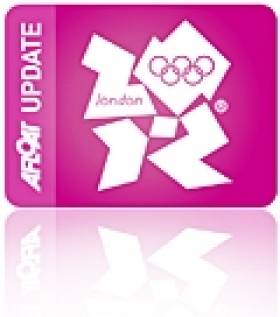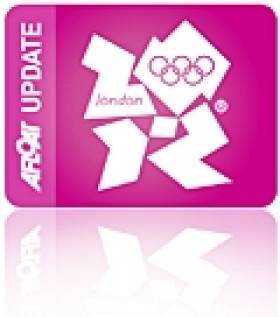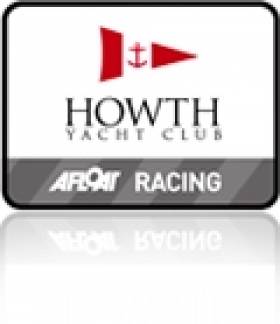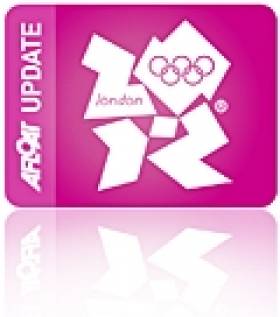Displaying items by tag: Olympic
#sailforgold – Peter O'Leary and David Burrows are wearing Gold tonight in Weymouth having won the most important pre-Olympic regatta of the season. They finished third in the Olympic Star class medal race to leap frog the Olympic and World champions raising further the expectation that the Cork-Dublin pair can deliver Ireland's first Olympic medal since 1980 in just under two months time.
The duo, who were fourth at last month's world championships in France performed consistently again this week staying in the top three in some of the toughest condtions of the season. Racing was cut short on Thursday when gales hit the Olympic venue.
The Irish Olympic bound pair were third overall heading in to this afternoon's medal race and a third place finish in the double points final this afternoon saw them jump ahead of Brazilian rivals Scheidt & Prada (BRA) and Brtiain's Olympic champions Percy and Simpson who were involved in a collision.
It is the second Gold for O'Leary in Weymouth he previously won with German crew Fritjof Kleen at Sail for Gold 2010.
Earlier today, in a big day for Irish sailing single hander Annalise Murphy took bronze in the Laser Radial and in the 49er class Ryan Seaton and Matt McGovern were seventh giving Ireland three medal possbilities at the Summer Olympics.
#sailforgold – Three Irish crews are in the Medal Races of tomorrow's washed out Skandia Sail for Gold Regatta after racing was scrubbed again today because of high winds.
Annalise Murphy in the Laser Radial, Peter O'Leary and David Burrows in the Star and Ryan Seaton & Matt McGovern in the 49er earn medal race starts by virtue of their top ten placings overall. The most likely medal prospect is O'Leary and Burrows who currently lie in the bronze medal position but tomorrow's racing will be worth double points so everything is still to play for.
Ger Owens and Scott Flanigan in the 470 class finish the regatta in 1st place in the Silver Fleet while James Espey finished 4th in the Laser Silver Fleet. Paralympians John Twomey, Ian Costello and Anthony Hegarty in the Sonar class finish 12th overall.
#sailforgold–Annalise Murphy believes she is on track for a top ten finish in her debut Olympics following a fine week at the Skandia Sail for Gold Regatta writes our special correspondent Paul Smith.
The Irish Laser Radial sailor picked up a win and a third place from her two races on day four in Weymouth, as the series entered the gold fleet stage.
Murphy, of Dublin, is now ranked fifth overall, with China's Lijia Xu in first and Britain's Alison Young second. Sari Mutala, of Finland, is third.
The National Yacht Club's Murphy is pleased with how her week has gone so far as she steps up her preparations for London 2012, and she is keen to illustrate her credentials.
"I've had a pretty consistent week, I had one bad race on Wednesday which is probably going to affect me overall in the end but I'm pretty happy," said the 22-year-old, who picked up a further first place on day three.
"I have had much more consistent results than usual so it is good.
"I came here and wanted to be in the top ten to get some medal experience, because every medal race here is important as it is like a step towards the Olympics.
"This will be my first Olympics so I am just going to try and get a good experience. I want to finish in the top ten and hopefully that will give me a good stepping stone towards 2016 but I don't know, anything can happen."
Providence Resources is the sponsor of the Irish Olympic Sailors
Investment specialist Skandia is the principal sponsor of the British sailing team
Murphy Packs a Punch as Weymouth Winds Reach 25 Knots
#sailforgold – Capitalising on her favourite conditions at the mid point of the Skandia Sail for Gold regatta in Weymouth today Olympic bound Laser Radial Sailor Annalise Murphy scored a first and a third. They are important scores that move the Dun Laoghaire sailor up to fifth overall, virtually assuring her of a place in Saturday's medal race.
Conditions have deteriorated in Weymouth for Day four of the event and continuous rain and winds of between 20 and 25 knots have prohibited many fleets from getting out on the water.
The Star class spent the day waiting ashore for a chance to sail but it never materialised leaving Peter O'Leary and David Burrows in third overall.
The race management team made the decision to move most of the racing into the more sheltered harbour area however this meant a reduction in course space. With the forecast for tomorrow looking to be even worse, the focus for today was on providing races for the Gold Fleets. This meant that the only Irish Olympic Sailors lined up to sail today were Annalise Murphy, Peter O'Leary & David Burrows and the 49er boys Ryan Seaton & Matt McGovern.
Ryan Seaton and Matt McGovern finished 12th in their first and only race of the day, putting them 10th overall.
Ger Owens and Scott Flanigan in the 470 Silver Fleet, James Espey in the Laser Silver Fleet and the Paralympic Sonar team were not racing today.
Tomorrow will be the final day of racing before the top 10 in each class progress to the medal races on Saturday. Conditions do not look to be favourable but organisers remain confident about getting competitors out on the water.
#sailforgold – Olympic bound Irish duo David Burrows and Peter O'Leary are in medal contention at the Skandia Sail for Gold Regatta - and that is exactly what they intend to be when the Games itself gets underway writes our special correspondent Paul Smith.
Burrows and O'Leary compete in the star class and are ranked third after six races over the first three days of the regatta, which is being held at the Olympic venue in Weymouth.
An interrupted first day saw just one race, in which they came fifth, before claiming a second, fourth and first place on day two to lead overnight.
Yesterday was less successful as they discarded their seventh place in race five before claiming fifth in the final outing of the day. It leaves them trailing Britain's reigning Olympic champions Iain Percy and Andrew Simpson, and Robert Scheidt and Bruno Prada of Brazil.
Dublin-born Burrows, a veteran of three Olympics having competed in the star class in 1996 and finn in both 2000 and 2004, says the duo are content with their performance but are also looking at the bigger picture.
"We are just testing some things here, getting ready for the Olympics in a few weeks' time," said the 35-year-old.
"This is the last chance to really test a few things against all of the competitors who we are going to be racing against at the Olympics, and so we are just testing a few settings and gears and also getting used to the racecourse a bit better.
"Our goal is to be standing on the podium (at the Olympics) that is what we are here for.
"We are quite happy with how our progress is going so far, and we are happy with the week we are having here at the Sail for Gold Regatta.
"We are confident enough and we just need to stick to our programme.
"The result isn't so important. It is more about just learning about your equipment, your gear, and also the venue itself and the racecourse."
Burrows and Cork-born helmsman O'Leary, 29, came together in the star class in 2009, with their sights firmly set on London 2012.
And with the Games now under two months away, Burrows believes a successful week in Weymouth will stand them in good stead.
"The first day, the first race was late in the evening and we scored a fifth in that race and we were pretty happy with the good start," he said.
"On Tuesday we were delighted with ourselves. We had a very solid day, with three races in pretty relentless conditions, but it suited us as we are from Ireland so we are used to it, and we were very happy.
"It is Weymouth. I think you can have any conditions in the summer time as we have seen, so you just have to take anything that comes really."
More on sail for gold regatta: www.skandiateamgbr.com Investment specialist Skandia is the principal sponsor of the British sailing team
More: Irish Olympic sailing news
#sailforgold – Three Irish boats in the top ten of the Skandia Sail for Gold regatta marks a new high for the Irish Olympic sailing team with team efforts now focused on ensuring early advantages are maintained through consistent sailing as the competition edges closer to Saturday's medal race finals.
Although Peter O'Leary and David Burrows have lost their overall lead they have maintained a strong position in the top of the Star fleet. They had a seventh and a fiftth today which leaves them 3rd overall. Significantly it is the strongest competitors who have passed them out, Percy & Simpson (GBR) and Scheidt & Prada (BRA) who lead in first and second respectively.
The weather had improved slightly from Tuesday's inclement conditions, but it was still another tough day on the water. The moderate wind from the south-west peaked at around 19 knots, providing challenging sailing conditions in which only the best could thrive.
Belfast skiff pair Ryan Seaton and Matt McGovern had their third race win of the championship in the 49er class. The duo move up three places to ninth overall following an additional ninth and third in their other two races of the day.
In the Laser Radial Annalise Murphy of Dun Laoghaire also had a race win, finishing first in her second race of the day. Combined with the 15th from her first race she is inside the top 10, now seventh overall.
Unfortunately Ger Owens & Scott Flanigan were disqualified from their first race of the day. They slip one position to 24th overall following their 9th place in the second race of the day.
Laser sailor James Espey finished 25th and 28th in his two races. He lies 52nd overall in the 95 boat fleet.
And in the Paralympic Sonar class, John Twomey, Ian Costello and Anthony Hegarty lie 12th overall.
GBR's Andrew Simpson on Boat Speed Issues
#sailforgold– They might head into London 2012 as reigning Star champions but Andrew Simpson and Iain Percy admit they have still have work to do after a Jekyll and Hyde start to their Skandia Sail for Gold assault, already Ireland's Peter O'Leary and David Burrows are 11 points clear but everyone knows there is still a big fight ahead writes Ben Baker.
The British duo are getting an early taste of what to expect at the Olympics in two months time as they look to claim the Sail for Gold crown at the Weymouth and Portland National Sailing Academy for the first time since 2009.
But the duo, who were forced to settle for silver at last month's World Championships behind Brazilians Robert Scheidt and Bruno Prada, have had to endure a mixed bag so far on the south coast.
Simpson and Percy sit fourth after the second day, results of first and third being sandwiched between finishes of seventh and 12t.
There is still time to close the gap on the leaders however, O'Leary and Burrows 11 points ahead, and Simpson insists they will continue to close the gap right up until the Games themselves.
"Day two was a tricky day," Simpson said. "We were struggling a bit for speed but it's good racing.
"It's tricky conditions and a lot of people did well and badly in races. We kept struggling but catching up which is good but struggling for speed against some of the guys so we have got a bit of work to do to find out what is going wrong.
"We had a first and a third so we are catching up now. There is a long way to go in this series and we aren't far off I don't think and won't be far behind so we have just got to work hard and see how it goes.
"This regatta is a good check in of where you are. You need to be close to where you need to be for the Games as it's not long now.
"You can't be far behind or miles away, you need to work on where you are and what you have got to do next."
For more: www.skandiateamgbr.com. (Investment specialist Skandia is the principal sponsor of the British sailing team).
For more: Irish Olympic Sailing news
Rita Wins Howth Yacht Club 17 Race
HOWTH YACHT CLUB. TUE + SAT SERIES 2 (RACE) 05/06/2012 17 Footer SCRATCH: 1, Rita Curley/Lynch; 2, Pauline O'Doherty/Ryan; 3, Isobel B & C Turvey; 17 Footer HCAP: 1, Pauline O'Doherty/Ryan; 2, Anita Cassidy/Faherty; 3, Rita Curley/Lynch TUESDAY SERIES 2 Puppeteer SCRATCH: 1, Yellow Peril N Murphy; 2, Harlequin Clarke/Egan; 3, Nefertari Morgan/Murray; Squib SCRATCH: 1, Kerfuffle Craig/Ruane; 2, Shadowfax P Merry; 3, Fantome R McDonell; Etchells SCRATCH: 1, Kootamundra D O'Grady; 2, Fetching Quinn/O'Flaherty; 3, Jabberwocky S Knowles; Puppeteer HPH: 1, Schiggy G Kennedy; 2, Mr Punch NiBhraonain/Wilson; 3, Nefertari Morgan/Murray; Squib HPH: 1, Shadowfax P Merry; 2, Kerfuffle Craig/Ruane; 3, Fantome R McDonell
O'Leary and Burrows Take the Lead in Sail for Gold
#sailforgold – After a most consistent display Irish Olympic pairing Peter O'Leary and David Burrows have shot in to the lead of the Star keelboat class in day two of the Skandia Sail for Gold Regatta in Weymouth today.
The great British weather produced its most horrible best on day two but O'Leary and Burrows brightened things up on the water moving up from fifth to first overall.
The Star class share the most distant course on the Weymouth and Portland sailing waters with the Finn, and they too had three races scheduled, and sailed them. It was the Irish team, – perhaps enjoying the weather more than some of their competitors – that had the best day. O'Leary and Burrows scored a first, second and fourth to hold a two point lead from the World Champions, Robert Scheidt and Bruno Prada.
Last night on the team facebook page a happy O'Leary declared ; '4, 2 & 1. Plenty of pace! 2 races tomorrow in plenty of breeze'
Robert Scheidt was one of those not enjoying the weather so much. "We are really happy with those results but also quite tired with it being a rough day and doing three races. Six- seven hours on the water so I am very much looking forward to a shower!" Another man having a tough day was the 1988 Star Gold Medallist, Mike McIntyre, whose return to the fleet ended badly – he was on port tack on the first beat of the second race when John Gimson (crewed by Dun Laoghaire's Anthony Shanks) tried to duck behind him. The manoeuvre went badly wrong and Gimson crashed into the gold medallist – fortunately McIntyre had borrowed the boat from Gimson!
Ryan Seaton and Matt McGovern continued where they left off yesterday and had their second race win in the 49er class today. They placed 12th in their other two races and now lie 12th overall.
In the Laser Radial, Annalise Murphy also had a solid day on the water in the Laser Radial. She sailed two races placing third and fourth respectively in the 70 boat fleet. She goes into the third day of racing tomorrow 11th overall.

The Star class scoreboard showing Ireland leading tonight in Weymouth
The newest of the team, Ger Owens and Scott Flanigan had a consistent day in the 470 fleet. The youngest of the Irish sailors, Scott Flanigan who is only 19, and his helm Ger placed 7th in both of their races leaving them 23rd overall.
Laser sailor James Espey from Bangor finished 28th and 32nd in his two races. He lies 26th overall in the 95 boat fleet.
And in the Paralympic Sonar class, John Twomey, Ian Costelloe and Anthony Hegarty all from Cork had a 10th and 13th today.
#sailforgold –Ireland is off to a strong start despite the fickle conditions at today's Sail for Gold regatta in Weymouth. By early afternoon on the first day of the regatta all fleets had returned to shore as the wind had disappeared.
Skandia Sail for Gold 2012 kicked off today, featuring almost all of the medal contenders for the upcoming Olympic Games. Over seven hundred athletes from 59 nations poured out onto Portland Harbour and Weymouth Bay, the cream of world sailing ready to put a marker down for the coming Olympiad. But conditions were tough, the forecast was for a transitional day, with a new wind arriving and strengthening throughout the rest of the week. So while Portland Harbour and Weymouth Bay delivered racing, it did so in fits and starts.
Most of the Irish sailors had a long lunch break waiting for conditions to improve and eventually at around 4pm the fleets all launched again in very light conditions.
The day belonged to Ryan Seaton & Matt McGovern, the Belfast Lough duo in the 49er skiff who won the third race very late in the evening having finished 8th and 11th in the previous two races.
Peter O'Leary and David Burrows in the Star class finished 5th in their only race of the day just behind event favourites Robert Scheidt and Bruno Prada (Brazil) and ahead of Iain Percy and Andrew Simpson (Great Britain).
In the 70 strong Laser radial fleet Annalise Murphy from the National Yacht Club in Dun Laoghaire scored 16th & 8th in her two races of the day in 5 knots of wind.
Ireland's most recent Olympic qualifier James Espey in the Laser class had a great start to the regatta scoring eightth in his only race of the day.
Fresh from winning the Delta Lloyd regatta last weekend Ger Owens who will be sailing in his third Olympics in July with Scott Flanigan scored a 19th and 15th in the 470 class.
In the Paralympic Sonar class John Twomey with Ian Costello and Anthony Hegarty finished 10th in their only race of the day.
The 470 race course got the best of the deal, with two races for everyone and a relatively early finish. In the Men's competition, some familiar names popped out in front. Early race winners were British Olympic representatives Luke Patience and Stuart Bithell, along with the all-conquering Aussie duo of Mat Belcher and Malcolm Page, winners of the last three world championships. Belcher and Page won their second race as well, and lead overall at the end of the first day. But it was also a return to the water and an immediate return to form for Britain's double World Champions, Nic Asher and Elliot Willis who scored a second and a third to hold second overall.
Asher and Willis have been kept out of sailing through illness since a below-par World Championships in Perth last year, and this was their first regatta in 2012. In the meantime, rivals Patience and Bithell got the British Olympic slot for the Games – a bitter disappointment to double world champions that have yet to go to the Olympics. Asher commented, "I would like to carry on for Rio but we will make that decision after Skandia Sail for Gold with Sparky (Stephen Park; Skandia Team GBR Olympic Manager). I see other options are stepping into the Skiff or 49er. But it is fantastic to be back and we have some unfinished business here."
The Women's 470 fleet got underway in the afternoon and also completed two races – winners were the new British World Champions and Olympic representatives, Hannah Mills and Saskia Clark. They posted a first and a fourth to lead from Elise Rechichi and Belinda Stowell from Australia. This is a rivalry that will go all the way to the Games.
The story out on the Finn and Star race course – the furthest from the Weymouth and Portland National Sailing Academy – was more typical of the day. They went out in the morning, were sent back to the beach for lunch without any action, were then hauled back out on the water again in the afternoon to finally get a race in. After all that, it was Michael Hestbaek who took the win in the Stars with four-time medallist (two gold and two silver), Robert Scheidt in fourth.
The USA's Caleb Paine won the Finns, with another four-time medallist (three gold, one silver), Ben Ainslie in fifth. Paine commented, "It feels great to have won today obviously not being selected to represent [the USA] in the Olympics, so to beat the other guys who will be there feels great." But for Ainslie it wasn't so much about the results, "My focus for the week is learning, especially the equipment in the boat; the results aren't important this week it is just about getting the preparation right and learning as much about the venue as possible."
The Paralympic course was one of those that raced in both the morning and the afternoon – starting with one race each for the Sonar and the Skud in the morning. The Sonar's were won by Udo Hessels and Mischa Rossen of the Netherlands from Sven Reiger and Edmund Rath of Austria. In the SKUD 18, Qingdao bronze medallists, John Scott McRoberts and Stacie Louttit from Canada took the honours from Australia's Qingdao silver medallists Daniel Fitzgibbon and Liesl Tesch.
John Scott McRoberts commented, "It was great to be first today and we are looking forward to the rest of the week and the windy conditions which we prefer; particularly as we already had lots of practice at the Delta Lloyd regatta in light air." The 2.4mR fleet got out on the Paralympic course in the afternoon, and managed two races in the light conditions. Some very familiar faces were out the front, with both the Netherlands Thierry Schmitter and Megan Pascoe of Team GBR scoring a second and a third to tie for the lead overall, ahead of France's gold and silver medallist, Damien Seguin in third.
Getting the toughest deal were the men on the Laser course, it was very late when they finally got going, pushing on towards seven o'clock. Unsurprisingly, they only got one race in, and it was won by Simon Grotelueschen, beating countryman Philipp Buhl. The Women in the Laser Radial did better, with two races completed by a reasonable hour. It was Dongshuang Zhang of China that took a first and second place to lead overall from Canada's Isabella Bertold and Spain's Fatima Reyes.
It was also a very long day out on the Women's Match Racing course, they started at 10:00 and finished their eleventh flight at 20:20 – almost ten hours later. The only unbeaten teams at the end of the day were Australia's Olivia Price who won six from six and Silja Lehtinen with four from four. And with Russia's Ekaterina Skudina only losing one from six, these three currently top the standings, but there is a long way to go in this competition.
The 49ers took all day to get through it, but they finished three races for both fleets. At the top at the end of the day was Britain's Dave Evans and Ed Powys with two wins and a third. It gives them a solid jump from Austria's second-placed Nico Luca Marc Delle Karth and Nikolaus Leopold Resch. Evans commented, "We like the breeze so we are looking forward to the rest of week. Today was a condition we are ok in, but we don't really do that well in; so getting a good result was great for us."
The RS:X Women got two races in today, and it was Poland's Zofia Noceti-Klepacka that had the best of the day, with a first and a second, edging Britain's Bryony Shaw who had a solid couple of thirds, and Spain's Marina Alabau with a second and an eighth. It wasn't a surprise to Bryony Shaw, who commented afterwards, "We had a couple of light wind specialists up there in the first race and then the two girls who I see as my main rivals from Poland and Spain were there in the second race, really showing their experience when everyone was tired and a bit worn out after the first race, so it was a good little battle with those two."
Zofia Noceti-Klepacka reckons she will be stronger in the windier conditions forecast for the end of the week though – which may or may not worry Shaw. "I prefer it when the conditions are windier so I am looking forward to the rest of the week; the forecast looks great so it will be more fun," said Noceti-Klepacka.
The Men's RS:X got one race done in the morning and another in the afternoon. The day belonged to 2012 World Champion, Julien Bontemps of France, with a first and a third. It was just a one point better performance than Toni Wilhelm of Germany who scored a first and a fourth.



























